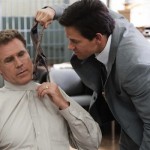Blue Caprice Review
Director Alexandre Moors’ Blue Caprice takes the horror you felt watching We Need to Talk About Kevin a few years ago (assuming you could sit through it) and sets it in the real world. That isn’t to say Lynn Ramsey’s film about an evil teenage boy who goes on a killing spree at his school is particularly fantastical. On the contrary, We Need to Talk About Kevin‘s verisimilitude was what made it so terrifying. But many Blue Caprice viewers will remember actually living through these events. It’s a dramatization of the Beltway sniper attacks of late 2002, and it’s as difficult to watch as you might expect. Rewarding, yes, but damn tough to sit through.
The film begins in Antigua where a boy named Lee (Tequan Richmond) has just been abandoned (again) by his mother. He goes swimming and nearly drowns if not for John (Isaiah Washington), who appears to be vacationing with his children. John takes Lee under his wing, and when they both arrive in John’s hometown of Tacoma, Washington, the latter is calling the former his dad.
Crumbs of information about John emerge subtly over the course of the film—his temper, his love of guns, his estranged relationship with his ex-wife and children (they weren’t vacationing per se). He holds very rigid thoughts about how the world works, and when things go against him or he thinks he’s being treated unjustly, he turns toward violent punishment, even anarchy. Not unlike The Joker, John wants to create chaos. He thinks we all live on the edge of collapse, and he thinks the world needs to feel it the way he does.
Lee, meanwhile, is a blank slate. Presumably, that helps him deal with his mother’s abandonment and his frequent bouts of starvation (he’s always on the prowl for a burger, it seems). The downside, of course, is that he’s easily malleable, and in the hands of a bad man (enter John), Lee can—and does—commit evil deeds.
All the fascinating character details and interplay are nothing without solid performances, and Blue Caprice has two. One, I should clarify, is great. Great, great, great. Isaiah Washington is a revelation as the black-hearted John. He never raises his voice, but there’s such an intensity in every word that comes out of his mouth. You can feel his malice. It’s the source of everything that is frightening about Blue Caprice.
His costar, Tequan Richmond, is good given what he’s asked to do. Lee is a wholly reactive individual. He lacks agency and a desire to acquire some. That means Richmond’s performance needs to be a little aloof, and it is. However, these qualities don’t light up the screen.
Getting back to the film as a whole, it walks a very fine line between thought-provoking and exploitative, and while there’s a lot to admire, one can’t help but ask the question: is this film necessary? By forcing his audience to actually relive recent history—a tragic history that doesn’t have any obvious or life-affirming takeaways—to spin his tale of man’s worst side, Moors doesn’t make things easy. Knowing there are men and women out there still living with the consequences of John and Lee’s senseless actions makes me feel awful. (Maybe that’s what Moors is going for.)
Whatever the case, Blue Caprice isn’t an experience I’d recommend to just anyone, nor is it a film I ever want to watch again. But it’s a well-crafted film with a precise tone that will haunt you for days. And in its moral favor, it judges its characters quite appropriately, which ultimately made the film easier—i.e. possible—to swallow.
















